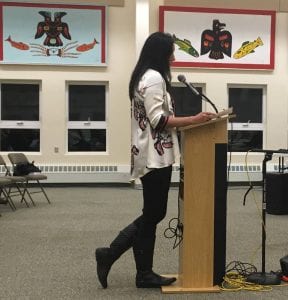
Melissa Johnson from the Ketchikan Indian Community Tribal Council talks to the Ketchikan School Board Wednesday at the Saxman Community Center. (KRBD photo by Leila Kheiry)
Alaska Native students in the Ketchikan School District have an “achievement gap,” and tribal leaders asked the school board Wednesday to work on closing that gap.
Wednesday’s board meeting took place at the Saxman Community Center. It’s become a tradition for the board to meet in Saxman in November, in honor of Alaska Native/Native American Heritage Month. That meeting also is when the board often hears concerns from local Native residents.
Melissa Johnson is vice president of the Ketchikan Indian Community Tribal Council, and chairs KIC’s education committee. She said years of mistreatment created a sense of distrust of public schools among the Alaska Native population.
Johnson said the district needs to work with tribes to overcome that distrust. One step in that direction would be to hire more Alaska Native teachers and administrators. She listed others:
“It is imperative that our history books tell the real stories of our indigenous people. It is imperative that our native children read stories in schools of Natives winning battles, Natives in leadership, glorifying Natives in history books like other ethnic groups,” she said. “It’s an imperative that our Native children speak the indigenous language – speak an indigenous language that’s been on the land for 10,000 years. It’s imperative that our Native children graduate high school, go to college, and become the next generation of Native leaders.”
Data compiled by the school district and KIC shows that the Alaska Native student population comprises about 30 percent of the district. Alaska Native teachers add up to less than 15 percent; and Alaska Native administration is about 7 percent.
The data also shows that Alaska Native students have lower proficiency than Caucasian students in English and language arts, and math; and have lower standardized test scores overall.
Gloria Burns also is on the KIC Tribal Council. She said she appreciates the district’s willingness to work with KIC on education programs, but there have been some recent shortfalls. She said a Native studies class, for example, wasn’t given adequate classroom space although funding was available. And a Native arts class was poorly advertised, so students weren’t aware of that opportunity.
Burns said those types of classes encourage students to attend school
“If it’s good for Native kids, it’s good for everybody,” she said. “If it is the gold standard that’s going to keep Native children in, creating an activity and a place of being, then that’s good for everybody.”
That idea was repeated by other speakers. Teacher Starla Agony talked about her first time in a classroom as a visiting instructor. She was there to share Haida language and culture with elementary kids, and said two non-Native children who previously had problems paying attention were completely engaged with the cultural program.
Also Wednesday, the board voted unanimously to establish the district’s Native Education Committee as a standing committee of the board. Previously, the committee was an ad hoc committee.
KIC Education and Training Director Katie Parrott said she appreciates the board’s choice to make the committee permanent.
“I just wanted to say thank you to the board for ratifying this committee in that way,” she said. “It’s an opportunity for the district to begin some of this work we’ve talked about and heard about that’s needed tonight.”
The committee includes representatives from the school board, local tribes and students.
That change to the board’s bylaws was approved in first reading and will come back for a second vote during the board’s next meeting on Nov. 28th.
The data comparing Alaska Native students with other student populations that was provided to the school board on Wednesday is available online.








